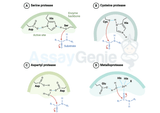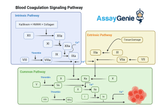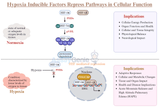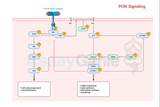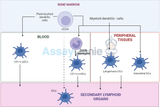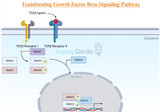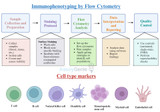Blog
Transduction vs Transfection: Understanding Gene Delivery Techniques
In the realm of molecular biology and genetic engineering, the ability to deliver genetic material into cells is fundamental for various research and therapeutic purposes. Two common methods employed for this purpose are transduction and transfection. While both techniques facilitate the introduction of exogenous genetic material into cells, they differ significantly in their mechanisms and applications. This article aims to elucidate the distinctions between transduction and transfection, highlighting their respective advantages, limitations, and applications. Transduction: Transduction is a process by which genetic material is transferred into a cell via a viral vector.
…
8th Feb 2024
Understanding Parkinson's Disease: Insights and Innovations
Parkinson's disease (PD) is a progressive neurological disorder that predominantly affects the motor system, leading to a wide range of symptoms including tremors, rigidity, bradykinesia (slowness of movement), and postural instability. This article delves into the pathophysiology, symptoms, diagnosis, and treatment options for Parkinson's disease, providing a comprehensive understanding of this complex condition. Understanding Parkinson's Disease Pathophysiology Parkinson's disease is characterized by the degeneration of dopamine-producing neurons in the substantia nigra, a region of the brain that plays a critical role in regulating movement. The decline in dopamine leve
…
8th Feb 2024
Alzheimer's Disease: A Comprehensive Insight
Alzheimer's disease stands as a formidable challenge in the realm of neurological disorders, characterized by its progressive nature and profound impact on cognitive functions. This article delves deeper into the facets of Alzheimer's disease, exploring its causes, mechanisms, clinical manifestations, and current therapeutic strategies, enriched with current scientific insights. Etiology and Risk Factors Genetic Factors The genetic landscape of Alzheimer's disease is complex, with both hereditary (familial AD) and sporadic forms. Key genes implicated in its pathogenesis include the amyloid precursor protein (APP), presenilin-1 (PSEN1), and presenilin-2 (PSEN2). Mutations i
…
7th Feb 2024
Protease vs Peptidase: Understanding Enzymatic Digestion
In the complex world of biochemical processes, enzymes play a crucial role in catalyzing various reactions necessary for life. Among these enzymes, proteases and peptidases are fundamental players involved in the breakdown of proteins and peptides, respectively. While their names might sound similar and their functions somewhat overlap, they serve distinct purposes in the realm of enzymatic digestion. Let's delve deeper into their definitions, functions, and types to gain a comprehensive understanding. Protease: The Protein Digesters Proteases, also known as proteolytic enzymes or proteinases, are enzymes that catalyze the hydrolysis of peptide bonds within proteins. These
…
6th Feb 2024
Blood Coagulation Signaling Pathways: A Critical Overview
Blood coagulation is a fundamental physiological process that prevents excessive bleeding when the vascular system is injured. It involves a complex cascade of events that lead to the formation of a stable fibrin clot. This process is tightly regulated by various signaling pathways to ensure that coagulation occurs promptly and appropriately in response to vascular injury, without leading to thrombosis or bleeding disorders. This article delves into the critical signaling pathways involved in blood coagulation, highlighting their roles, mechanisms, and the potential for therapeutic intervention. The Coagulation Cascade: An Overview The coagulation cascade is traditionally divided
…
5th Feb 2024
p38 MAPK Signaling Review
The p38 MAPK signaling pathway is an intracellular signaling pathway that plays a crucial role in cellular responses to various stressors and inflammatory stimuli. It is a part of the larger MAPK superfamily, which also includes ERK and JNK pathways. The p38 MAPK pathway is involved in regulating a wide range of cellular processes, including cell proliferation, differentiation, apoptosis, inflammation, and immune responses. Key Takeaways: p38 MAPK, part of the MAPK family, is key in cellular responses to stress and inflammation. This pathway regulates cell processes like proliferation, differentiation, apoptosis, and immune responses. The MAPK family includes ERKs, JNKs, and p38
…
1st Feb 2024
Serum vs. Plasma: A Deep Dive into Their Molecular Makeup and Implications for ELISA
Blood plasma and serum are essential components of blood and have distinct molecular compositions and uses in the medical and research fields. This article aims to elucidate the differences between serum and plasma and respond to the most frequently asked questions. Key Takeaways: Serum is blood fluid without clotting factors; plasma contains these factors. They're crucial in medical research, including ELISA, to measure various analytes. Different collection methods are used for serum and plasma. What is Serum vs Plasma? Blood consists of red and white cells, platelets, and a liquid portion, known as plasma. When blood is collected and coagulates, the solid components,
…
24th Jan 2024
Articular Cartilage Extracellular Matrix
Articular cartilage, a key player in joint function, owes its unique properties to its extracellular matrix (ECM). This complex, highly specialized structure is not only fundamental in maintaining joint integrity but also in ensuring smooth and efficient movement. The ECM of articular cartilage is a masterful creation of nature, intricately designed to withstand compressive forces while providing a lubricated surface for articulation. Understanding the Composition of ECM in Articular Cartilage Proteoglycans: The Hydration Masters: The ECM of articular cartilage is rich in proteoglycans, primarily aggrecan. These macromolecules play a crucial role in retaining water, giving
…
23rd Jan 2024
HIF Repress Pathways: An Insight into Cellular Oxygen Homeostasis
Hypoxia-inducible factors (HIFs) are pivotal in the cellular response to oxygen deprivation. These transcription factors regulate various aspects of cellular and systemic homeostasis in response to hypoxia. Central to their role is the activation of genes that aid in adaptation to low oxygen conditions. However, equally important, yet less emphasized, is their ability to repress certain pathways. This article delves into the mechanisms and implications of HIF-mediated repression pathways in cells. Mechanisms of HIF-Mediated Repression Transcriptional Repression Through HIF: HIFs function primarily as transcriptional activators. However, they can indirectly repress gene expr
…
22nd Jan 2024
MAPK Signaling in Inflammatory Cytokines Pathways
The Mitogen-Activated Protein Kinase (MAPK) pathway is a pivotal signaling cascade that plays a crucial role in mediating cellular responses to various external stimuli. This pathway is intricately involved in the regulation of inflammatory cytokines, key signaling molecules in the immune system. Understanding the MAPK signaling pathway in the context of inflammatory cytokines is essential for grasping the molecular basis of inflammation and its related disorders. Overview of MAPK Signaling Fundamental Components and Activation: MAPK signaling encompasses a series of protein kinases that transmit signals from the cell surface to the nucleus. These kinases include the Extrac
…
22nd Jan 2024
JAK-STAT Signaling Pathway: A Comprehensive Exploration
window.SHOGUN_IMAGE_V2_ELEMENTS = window.SHOGUN_IMAGE_V2_ELEMENTS || new Array();
window.SHOGUN_IMAGE_V2_ELEMENTS.push({ uuid: 's-45124fd5-9a75-444d-b680-b8339e2a814d' })
Progression of the JAK STAT Signalling Pathway Cellular communication is a complex network of molecular interactions that govern various physiological processes. Among the many signaling pathways, the Janus kinase-signal transducer and activator of transcription (JAK-STAT) pathway plays a pivotal role in mediating signals from the cell surface to the nucleus. This pathway is essential for regulating immune responses, cell proliferation, differentiation, and survival. In this article, we will delv
…
18th Jan 2024
MAPK Oxidative Stress Pathway: A Journey through Cellular Signaling
window.SHOGUN_IMAGE_V2_ELEMENTS = window.SHOGUN_IMAGE_V2_ELEMENTS || new Array();
window.SHOGUN_IMAGE_V2_ELEMENTS.push({ uuid: 's-e5394be4-6636-4558-9e32-20ef2f209b2b' })
In the intricate world of cellular signaling, the Mitogen-Activated Protein Kinase (MAPK) pathway plays a pivotal role in regulating various cellular processes. One facet of this pathway that has garnered significant attention is its involvement in managing oxidative stress—a condition marked by an imbalance between reactive oxygen species (ROS) and the cell's antioxidant defense mechanisms. In this article, we embark on a journey through the MAPK oxidative stress pathway, exploring its intri
…
18th Jan 2024
Adipokines and Insulin Signaling Pathways: An In-Depth Exploration
The prevalence of obesity and its associated metabolic disorders has risen dramatically in recent decades, presenting a significant global health challenge. Adipose tissue, once considered merely a storage site for excess energy, is now recognized as an active endocrine organ secreting a myriad of bioactive molecules known as adipokines. Among these adipokines, a key player in metabolic regulation is insulin, a hormone produced by the pancreas. Adipokines: Key Regulators of Metabolism Adipokines function as critical mediators between adipose tissue and various organs, influencing metabolic processes such as glucose homeostasis, lipid metabolism, and inflammation. Lep
…
18th Jan 2024
Unraveling the Complexity of the Notch Signaling Pathway: A Key Player in Development and Disease
The Notch signaling pathway is a highly conserved cellular communication system that plays a crucial role in various biological processes, including embryonic development, tissue homeostasis, and immune system function. Discovered over a century ago, the Notch pathway has since emerged as a complex and versatile signaling network that regulates cell fate decisions and maintains tissue integrity. This article aims to provide an overview of the Notch signaling pathway, its components, and its diverse roles in development and disease. Basic Components of the Notch Signaling Pathway: The Notch pathway consists of a family of transmembrane receptors, known as Notch receptors, a
…
17th Jan 2024
Unlocking Cellular Adaptation: The HIF Enhancer Pathway and Its Implications in Hypoxia Response
Hypoxia, or low oxygen levels, poses a significant challenge to cells, necessitating rapid and efficient adaptation mechanisms. The Hypoxia-Inducible Factor (HIF) pathway is a well-known regulator of cellular responses to hypoxia, orchestrating the expression of genes involved in angiogenesis, erythropoiesis, and glycolysis. It plays a pivotal role in cellular adaptation to low oxygen conditions, ensuring survival and homeostasis in diverse physiological and pathological settings. Recent studies have uncovered an additional layer of complexity in HIF regulation, known as the HIF enhancer pathway. This article explores the mechanisms, regulation, and significance of the HIF enhancer pa
…
12th Jan 2024
Dendritic Cells: Tracing the Developmental Lineage Pathway
Dendritic cells (DCs) are pivotal in the immune system, orchestrating innate and adaptive immune responses. Understanding their developmental lineage pathway is crucial in immunology, particularly in the context of cancer and infection responses. Introduction to Dendritic Cells Dendritic cells are unique antigen-presenting cells (APCs) that play a crucial role in the immune system. They are known for their ability to capture and present antigens, thereby bridging innate and adaptive immunity. DCs are heterogeneous, comprising various subsets with distinct phenotypes and functions. This diversity is a result of their complex developmental lineage. Origin and Early Development
…
5th Jan 2024
Deciphering the Intricacies of TGF-Beta Signaling Pathway
Transforming Growth Factor-Beta (TGF-β) signaling pathway plays a pivotal role in orchestrating various cellular processes, ranging from embryonic development to tissue homeostasis and immune response modulation. This intricate pathway is crucial for maintaining cellular balance, and dysregulation can contribute to a myriad of diseases, including cancer, fibrosis, and immune disorders. In this article, we delve into the key components and mechanisms that characterize the TGF-β signaling pathway. Key Components of TGF-Beta Signaling Pathway: TGF-β Ligands: The TGF-β family comprises multifunctional cytokines, with TGF-β1, TGF-β2, and TGF-β3 being
…
24th Aug 2023
Xeroderma pigmentosum: Causes, Inheritance, Treatment and Diagnosis
What is Xeroderma Pigmentosum? Xeroderma pigmentosum (XP) also known De Sanctis-Cacchione syndrome is a rare genetic disorder that affects the skin, eyes and central nervous system. It is caused by a defect in the Xeroderma pigmentosum gene, which results in an inability to repair DNA damage caused by ultraviolet light. This can lead to a wide range of symptoms, including sunburns, freckles, skin cancer and neurological problems. XP is inherited in an autosomal recessive manner. Till date about 8 inherited forms of Xeroderma pigmentosum has been identified XP-A to XP-G. Diagnosis of Xeroderma pigmentosum can be difficult, as there is no single definitive test. A combination of test
…
23rd Aug 2023
Immunophenotyping by Flow Cytometry and Cell Type Markers
Immunophenotyping by Flow Cytometry Immunophenotyping is a technique used in the field of immunology and cell biology to identify and classify cells based on the specific proteins or molecules found on their surfaces, known as cell surface markers or antigens. These markers provide valuable information about the type, state, and characteristics of individual cells within a larger population. Immunophenotyping is particularly important in fields such as immunology, hematology, oncology, and infectious diseases, where understanding cell populations and their properties is crucial. The primary tool used for immunophenotyping is flow cytometry, although other methods like immu
…
23rd Aug 2023
Oxidative Stress: Causes, Biomarkers & Disease
Oxidative Stress Definition
Oxidative stress is a condition that results when the body produces or consumes more reactive oxygen species (ROS) than it can neutralize. ROS are unstable molecules that can damage cells, proteins, and DNA. Oxidative stress has been implicated in a wide range of diseases, including heart disease, cancer, Alzheimer's disease, and Parkinson's disease. In this article, we will discuss oxidative stress and explore its role in disease. We will also look at some of the most common oxidative stress markers.
Oxidants and reductants can be formed in cells by losing or gaining a single electron, which makes them oxidizing or reducing age
…
23rd Aug 2023
Waardenburg Syndrome and Klein-Waardenburg Syndrome
Waardenburg Syndrome: A Rare Genetic Disorder Affecting Pigmentation, Hearing, and More
Waardenburg Syndrome (WS) is a fascinating and rare genetic disorder that impacts various aspects of an individual's appearance and sensory abilities. First described by Dutch ophthalmologist Petrus Johannes Waardenburg in the 1950s, WS is characterized by distinctive features, including changes in pigmentation, hearing loss, and facial abnormalities.
Table of Contents
Jump to a section:
- Waardenburg Syndrome Classification
- Waardenburg Syndrome Causes
- Waardenburg Syndrome Type 3
- Related Kits
.nav__list {
list-style:
…
24th Jul 2023
A Quick Guide to Myelin
The myelin sheath is an insulating layer around nerve cells. It is made up of a substance called myelin, which is produced by special cells called oligodendrocytes. Myelin protects the nerve cells and to keep them maintain their function. Myelin is important for the proper function of the nervous system. It helps to speed up nerve impulses and prevents them from becoming mixed up. Without myelin, nerve impulses would move slowly and would be easily confused. Myelin is also important for the repair of damaged nerves. When a nerve is damaged, the myelin sheath around it is also damaged. The oligodendrocytes that produce myelin can also repair the myelin sheath. This process is called myeli
…
19th Jul 2023
Sepsis and Immune Dysregulation
Exploring sepsis: a critical imbalance in the immune response to infection. Key Takeaways: Sepsis is a severe, immune-driven response to infection causing systemic inflammation and potential organ damage. It progresses through stages: initial sepsis, severe sepsis, and septic shock, each with increasing severity. Complications include organ failure, septic shock, ARDS, blood clots, and long-term impairments. Immune responses in sepsis vary from hypo-inflammation (weak) to hyper-inflammation (excessive). Understanding these responses is key for effective sepsis treatment and management. What is Sepsis? Sepsis is a life-threatening condition that arises when the bod
…
29th Jun 2023
Biomarkers in sepsis: Their Role in Early Detection and Management
Sepsis, a life-threatening condition, is characterized by a dysregulated immune response to an infection, leading to systemic inflammation and organ dysfunction. Biomarkers, as measurable indicators of biological processes, hold immense potential in the field of sepsis diagnosis, prognosis, and management. In this article, we explore the critical role that biomarkers play in sepsis, particularly their significance in early detection and diagnosis. We delve into the latest research and advancements in biomarker identification, their association with the immune response duri
…
28th Jun 2023




